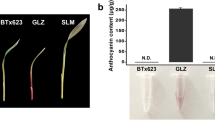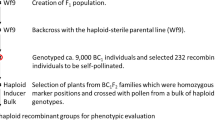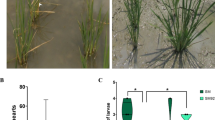Abstract
Compared to japonica, the lower genetic transformation efficiency of indica is a technical bottleneck for rice molecular breeding. Specifically, callus browning frequently occurs during the culture of the elite indica variety 93-11, leading to poor culturability and lower genetic transformation efficiency. Here, 67 QTLs related to culturability were detected using 97 introgression lines (designated as 9DILs) derived from Dongxiang common wild rice (DXCWR, Oryza rufipogon Griff.) with 93-11 genetic background, explaining 4% ~12% of the phenotypic variations. The QTL qCBT9 on chromosome 9 was a primary QTL for reducing callus browning derived from DXCWR. Five 9DILs with light callus browning and high differentiation were screened. We evaluated the callus browning index (CBI) of 100 F2 population crossed of 93-11 and 9DIL71 and the recombinant plants screened from 3270 individuals. The qCBT9 was delimited to a ~148kb region between the markers X16 and X23. RNA-seq analysis of DEGs between 9DIL71 and 93-11 showed three upregulated DEGs (Os09g0526500, Os09g0527900, Os09g0528200,) and three downregulated DEGs (Os09g0526700, Os09g0526800, Os09g0527700) were located in the candidate region of qCBT9. Furthermore, callus browning may be involved in cell senescence and death caused by oxidative stress. The differentiation of indica and japonica in this region suggested that qCBT9 was possibly a vital QTL contributed to better culturability of japonica. Our results laid a foundation for further cloning of the gene for reduced callus browning in O. rufipogon, and also provided a new genetic resource and material basis for improving the culturability and genetic transformation efficiency of cultivated rice.







Similar content being viewed by others

Data availability
The RNA-seq data of 93-11 and 9DIL71 have been deposited in the Sequence Read Archive (SRA) under accession code PRJNA1062274.
References
Abe T, Futsuhara Y (1986) Genotypic variability for callus formation and plant regeneration in rice (Oryza sativa L.). Theor Appl Genet 72(1):3-10. https://doi.org/10.1007/BF00261446
Anantharaman V, Aravind L (2003) Evolutionary history, structural features and biochemical diversity of the NlpC/P60 superfamily of enzymes. Genome Biol 4 (2). https://doi.org/10.1186/gb-2003-4-2-r11
Atanassov A, Zagorska N, Boyadiev P& Djilianoy D, (1995) In vitro production of haploid plants. World J Microbiol Biotechnol 11(4):400–408. https://doi.org/10.1007/BF00364615
Chen H, Ma B, Zhou Y, He S, Tang S, Lu X, Xie Q, Chen S, Zhang J (2018) E3 ubiquitin ligase SOR1 regulates ethylene response in rice root by modulating stability of Aux/IAA protein. Proc Natl Acad Sci USA 115(17):4513–4518. https://doi.org/10.1073/pnas.1719387115
Chu C, Wang C, Sun C, Chen H, Yin K, Chu C (1975) Establishment of an efficient medium for another culture of rice through experiments on the nitrogen source. Sci Sin 18(5):659–668. https://doi.org/10.1007/BF00261446
Datta K, Datta SK (2006) Indica rice (Oryza sativa, BR29 and IR64) Methods Mol Biol 343:201–212. https://doi.org/10.1385/1-59745-130-4:201
Dong YS, Fu CH, Su P, Xu XP, Yuan J, Wang S, Zhang M, Zhao CF, Yu LJ (2016) Mechanisms and effective control of physiological browning phenomena in plant cell cultures. Physiol Plant 156(1):13–28. https://doi.org/10.1111/ppl.12382
Dabul ANG, Belefant-Miller H, RoyChowdhury M, Hubstenberger JF, Lorence A, Phillips GC (2009) Screening of a broad range of rice (Oryza sativa L.) germplasm for in vitro rapid plant regeneration and development of an early prediction system. In Vitro Cell Dev Biol-Plant 45:414–420. https://doi.org/10.1016/j.egg.2022.100128
Gamborg OL, Miller RA, Ojima K (1968) Nutrient requirements of suspension culture of soybean roots cells. Exp Cell Res 50(1):151–158. https://doi.org/10.1016/0014-4827(68)90403-5
Han C, He Y, Wu L, Jia L, Wang L, E Z (2023) Research Progress in the Function of Basic Leucine Zipper (bZIP) Protein Family in Rice. Chinese Journal OF Rice Science. 37(4): 436-448. https://doi.org/10.16819/j.1001-7216.2023.221018
Han M, Gleave AP, Wang T (2010) Efficient transformation of actinidia arguta byreducing the strength of basal salts in the medium to alleviate callus browning. Plant Biotechnol Rep 4(2):129–138. https://doi.org/10.1007/s11816-010-0128-1
He Y, Guo X, Lu R, Lu R, Niu R, Pasapula V, Hou P, Cai F, Xu Y, Chen F (2009) Changes in morphology and biochemical indices in browning callus derived from Jatropha curcas hypocotyls. Plant Cell Tiss Organ Cult 98:11–17. https://doi.org/10.1007/s11240-009-9533-y
Hiei Y, Ohta S, Komari T, Kumashiro T (1994) Efficient transformation of rice (Oryza sativa L.) mediated by Agrobacterium and sequence analysis of the boundaries of the T-DNA. Plant J 6(2):271–282. https://doi.org/10.1046/j.1365-313x.1994.6020271.x
Huang C, Zhang J, Zhou D, Huang Y, Su L, Yang G, Luo W, Chen Z, Wang H, Guo T (2021) Identification and candidate gene screening of qCIR9.1, a novel QTL associated with anther culturability in rice (Oryza sativa L.). Theor Appl Genet 134(7):2097-2111. https://doi.org/10.1007/s00122-021-03808-z
Huang X, Kurata N, Wei X, Wang ZX, Wang A, Zhao Q, Zhao Y, Liu K, Lu H, Li W, Guo Y, Lu Y, Zhou C, Fan D, Weng Q, Zhu C, Huang T, Zhang L, Wang Y, Feng L, Furuumi H, Kubo T, Miyabayashi T, Yuan X, Xu Q, Dong G, Zhan Q, Li C, Fujiyama A, Toyoda A, Lu T, Feng Q, Qian Q, Li J, Han B (2012) A map of rice genome variation reveals the origin of cultivated rice. Nature 490:497–501. https://doi.org/10.1038/nature11532
Jia H, Yi D, Yu J, Xue S, Xiang Y, Zhang C, Zhang Z, Zhang L, Ma Z (2007) Mapping QTLs for tissue culture response of mature wheat embryos. Mol Cells 23(3):323–330
Jiang M, Zhang J (2003) Cross-talk between calcium and reactive oxygen species originated from NADPH oxidase in abscisic acid-induced antioxidant defence in leaves of maize seedlings. Plant, Cell and Environment 26(3):929–939. https://doi.org/10.1046/j.1365-3040.2003.01025.x
Krishna H, Sairam RK, Singh SK, Patel VB, Sharma RR, Grover M, Nain L, Sachdev A (2008) Mango explant browning: effect of ontogenic age, mycorrhization and pre-treatments. Sci Hortic 118(2):132–138. https://doi.org/10.1016/j.scienta.2008.05.040
Li Z, Duan S, Kong J, Li S, Li Y, Zhu Y (2007) A single genetic locus in chromosome 1 controls conditional browning during the induction of calli from mature seeds of Oryza sativa ssp. indica. Plant Cell Tiss Org 89:237–245. https://doi.org/10.1007/s11240-007-9248-x
Li S, Yan S, Wang Ah, Zou G, Huang X, Han B, Qian Q, Tao Y (2013) Identification of QTLs associated with tissue culture response through sequencing-based genotyping of RILs derived from 93–11 ×Nipponbare in rice (Oryza sativa). Plant Cell Rep 32:103–116. https://doi.org/10.1007/s00299-012-1345-6
Lin A, Wang Y, Tang J, Xue P, Li C, Liu L, Hu B, Yang F, Loake GJ, Chu C (2012) Nitric oxide and protein S-nitrosylation are integral to hydrogen peroxide-induced leaf cell death in rice. Plant Physiol 158(1):451–464. https://doi.org/10.1104/pp.111.184531
Lin YJ, Zhang Q (2005) Optimising the tissue culture conditions for high efficiency transformation of indica rice. Plant Cell Rep 23(8):540–547. https://doi.org/10.1007/s00299-004-0843-6
Ma F, Lu R, Liu H, Shi B, Zhang J, Tan M, Zhang A, Jiang M (2012) Nitric oxide-activated calcium/calmodulin-dependent protein kinase regulates the abscisic acid-induced antioxidant defence in maize. J Exp Bot 63(13):4835–4847. https://doi.org/10.1093/jxb/ers161
Manly KF, Cudmore RJ, Meer JM (2001) Map Manager QTX, cross-platform software for genetic mapping. Mamm Genome 12:930–932. https://doi.org/10.1007/s00335-001-1016-3
Meng L, Li H, Zhang L, Wang J (2015) QTL IciMapping: Integrated software for genetic linkage map construction and quantitative trait locus mapping in biparental populations. Crop J 3(3):269–283. https://doi.org/10.1016/j.cj.2015.01.001
Nishimura A, Ashikari M, Lin S, Takashi T, Angeles ER, Yamamoto T, Matsuoka M (2005) Isolation of a rice regeneration quantitative trait loci gene and its application to transformation systems. Proc Natl Acad Sci USA 102(33):11940–11944. https://doi.org/10.1073/pnas.0504220102
Nishimura A, Aichi I, Matsuoka M (2006) A protocol for Agrobacterium-mediated transformation in rice. Nat Protoc 1:2796–2802. https://doi.org/10.1038/nprot.2006.469
Nishimura A (2020) Agrobacterium Transformation in the Rice Genome. Methods Mol Biol 2072:207–216. https://doi.org/10.1007/978-1-4939-9865-4_17
Ozawa K, Kawahigashi H (2006) Positional cloning of the nitrite reductase gene associated with good growth and regeneration ability of calli and establishment of a new selection system for Agrobacterium-mediated transformation in rice (Oryza sativa L.). Plant Sci 170(2):384–393. https://doi.org/10.1016/j.plantsci.2005.09.015
Passaia G, Margis-Pinheiro M (2015) Glutathione peroxidases as redox sensor proteins in plant cells. Plant SCI 234:22–26. https://doi.org/10.1016/j.plantsci.2015.01.017
Rogers SO, Rehner S, Bledsoe C, Mueller GJ, Ammirati JF (1989) Extraction of DNA from basidiomycetes for ribosomal DNA hybridizations. Can J Bot 67(4):1235–1243. https://doi.org/10.1139/b89-161
Swain A, Dash M, Behera Molla KA, D, Baig JM, Dash BP, (2018) In vitro regeneration of some economically important elite indica rice genotypes. An Int J Rice 55(1):107. https://doi.org/10.5958/2249-5266.2018.00013.9
Sundararajan S, Sivaraman B, Rajendracn V, Ramalingam S (2017) Tissue culture and Agrobacterium-mediated genetic transformation studies in four commercially important indica rice cultivars. J Crop Sci Biotechnol 20(3):175–183. https://doi.org/10.1007/s12892-017-0045-0
Sahoo KK, Tripathi AK, Pareek A, Sopory SK, Singla-Pareek SL (2011) An improved protocol for efficient transformation and regeneration of diverse indica rice cultivars. Plant Methods 7:49. https://doi.org/10.1007/s00299-019-02505-y
Shi Y (2002) Mechanisms of caspase activation and inhibition during apoptosis. Mol Cell 9(3):459–470. https://doi.org/10.1016/s1097-2765(02)00482-3
Shri M, Rai A, Verma PK, Misra P, Dubey S, Kumar S, Verma S, Gautam N, Tripathi RD, Trivedi PK, Chakrabarty D (2013) An improved Agrobacterium-mediated transformation of recalcitrant indica rice (Oryza sativa L.) cultivars. Protoplasma 250:631–636. https://doi.org/10.1007/s00709-012-0439-x
Tang Y, Wang M, Cao L, Dang Z, Ruan N, Wang Y, Huang Y, Wu J, Zhang M, Xu Z, Chen W, Li F, Xu Q (2022) OsUGE3 - mediated cell wall polysaccharides accumulation improves biomass production, mechanical strength, and salt tolerance. Plant Cell Environ 45:2492–2507. https://doi.org/10.1111/pce.14359
Taguchi-Shiobara F, Lin S, Tanno K, Komatsuda T, Yano M, Sasaki T, Oka S (1997) Mapping quantitative trait loci associated with regeneration ability of seed callus in rice, Oryza sativa L. Theor Appl Genet 95:823–833. https://doi.org/10.1007/s001220050632
Taguchi-Shiobara F, Yamamoto T, Yano M, Oka S (2006) Mapping QTLs that control the performance of rice tissue culture and evaluation of derived near-isogenic lines. Theor Appl Genet 112:968–976. https://doi.org/10.1007/s00122-005-0200-3
Takeuchi Y, Abe T, Sasahara T (2000) RFLP mapping of QTLs influencing shoot regeneration from mature seed-derived calli in rice. Crop Sci 40(1):245–247. https://doi.org/10.2135/cropsci2000.401245x
Thomas TD (2008) The role of activated charcoal in plant tissue culture. Biotechnol Adv 26(6):618–631. https://doi.org/10.1016/j.biotechadv.2008.08.003
Tóth K, Haapala T, Hohtola A (1994) Alleviation of browning in oak explants by chemical pretreatment. Biol Plant. 36:511–517. https://doi.org/10.1007/BF02921170
Trapnell C, Williams BA, Pertea G, Mortazavi A, Kwan G, van Baren MJ, Salzberg SL, Wold BJ, Pachter L (2010) Transcript assembly and quantification by RNA-Seq reveals unannotated transcripts and isoform switching during cell differentiation. Nat Biotechnol 28:511–515. https://doi.org/10.1038/nbt.1621
Uchendu E.E, Paliyath G, Brown D.C.W & Saxena P.K (2011) In vitro propagation of North American ginseng (Panax quinquefolius L.). Vitr. Cell Dev.-Plant. 47(6):710-718. https://doi.org/10.1007/s11627-011-9379-y
Wang M, Van Bergen S, Van Duijn B (2000) Insights into a key developmental switch and its importance for efficient plant breeding. Plant Physiol 124(2):523–530. https://doi.org/10.1104/pp.124.2.523
Wang Y, Yang X, Xu G, Ye X, Ji Y, Lou X, Su J, Sun C, Fu Y, Zhang K (2023) Mapping quantitative trait loci associated with callus browning in Dongxiang common wild rice (Oryza rufipogon Griff.). Mol Biol Rep 50:3129–3140. https://doi.org/10.1007/s11033-023-08279-7
Yang H, Yang S, Li Y, Hua J (2007) The Arabidopsis BAP1 and BAP2 genes are general inhibitors of programmed cell death. Plant Physiol 145(1):135–146. https://doi.org/10.1104/pp.107.100800
Ye N, Li H, Zhu G, Liu Y, Liu R, Xu W, Jing Y, Peng X, Zhang J (2014) Copper suppresses abscisic acid catabolism and catalase activity, and inhibits seed germination of rice. Plant Cell Physiol 55(11):2008–2016. https://doi.org/10.1093/pcp/pcu136
Zangar RC, Davydov DR, Verma S (2004) Mechanisms that regulate production of reactive oxygen species by cytochrome P450. Toxicol Appl Pharmacol 199:316–331. https://doi.org/10.1016/j.taap.2004.01.018
Zhang A, Jiang M, Zhang J, Ding H, Xu S, Hu X, Tan M (2007) Nitric oxide induced by hydrogen peroxide mediates abscisic acid-induced activation of the mitogen-activated protein kinase cascade involved in antioxidant defense in maize leaves. New Phytol 175(1):36–50. https://doi.org/10.1111/j.1469-8137.2007.02071.x
Zhang H, Liu Y, Wen F, Yao D, Wang L, Guo J, Ni L, Zhang A, Tan M, Jiang M (2014) A novel rice C2H2-type zinc finger protein, ZFP36, is a key player involved in abscisic acid-induced antioxidant defence and oxidative stress tolerance in rice. J Exp Bot 65(20):5795–5809. https://doi.org/10.1093/jxb/eru313
Zhang K, Su J, Xu M, Zhou Z, Zhu X, Ma X, Hou J, Tan L, Zhu Z, Cai H, Liu F, Sun H, Gu P, Li C, Liang Y, Zhao W, Sun C, Fu Y (2020) A common wild rice-derived BOC1 allele reduces callus browning in indica rice transformation. Nat Commun 11:443. https://doi.org/10.1038/s41467-019-14265-0
Zhang K, Yin Z, Xu X, Pu C, Li Q, Wu di, Sun C, Fu Y, (2016) Quantitative trait loci for mature embryo culturability traits from Yuanjiang common wild rice (Oryza rufipogon Griff.). Indian J Genet Pl Br 76:167–172. https://doi.org/10.5958/0975-6906.2016.00037.7
Zhao J, Qin J, Song Q, Sun C, Liu F (2016) Combining QTL mapping and expression profile analysis to identify candidate genes of cold tolerance from Dongxiang common wild rice (Oryza rufipogon Griff.). J Integr Agr 15(9):1933-1943. https://doi.org/10.1016/S2095-3119(15)61214-X
Zhao L, Zhou H, Lu L, Liu L, Li X, Lin Y, Yu S (2009) Identification of quantitative trait loci controlling rice mature seed culturability using chromosomal segment substitution lines. Plant Cell Rep 28:247–256. https://doi.org/10.3390/ijms20040900
Acknowledgements
This project was supported by the National Natural Science Foundation of China (Grant Number 32172016) and Guided Project of Sanya Institute of China Agricultural University (Grant Number SYND-2021-4).
Funding
National Natural Science Foundation of China, 32172016, Kun Zhang , Sanya Yazhou Bay Science and Technology City, SYND-2021-4,Yongcai Fu
Author information
Authors and Affiliations
Contributions
X.L. performed the experiments, analyzed the data and wrote the manuscript. J.S. helped to assess the phenotype. Y.X. helped to identify the genotype of F2 population. M.C., Q.Z. and Y.L. helped to perform the experiments. K.Z. conceived and designed the experiments, analyzed the data, wrote and modified the manuscript. C.S. provided a good experiment platform and guided the experiment. Y.F. conceived and designed the experiments, supervised the research and modified the manuscript. All authors read and approved the final manuscript.
Corresponding author
Ethics declarations
Conflict of interests
The authors declare no conflicts of interest.
Additional information
Publisher's Note
Springer Nature remains neutral with regard to jurisdictional claims in published maps and institutional affiliations.
Supplementary information
Below is the link to the electronic supplementary material.
Rights and permissions
Springer Nature or its licensor (e.g. a society or other partner) holds exclusive rights to this article under a publishing agreement with the author(s) or other rightsholder(s); author self-archiving of the accepted manuscript version of this article is solely governed by the terms of such publishing agreement and applicable law.
About this article
Cite this article
Lou, X., Su, J., Xiong, Y. et al. Identification of QTLs responsible for culturability, and fine-mapping of QTL qCBT9 related to callus browning derived from Dongxiang common wild rice (Oryza rufipogon Griff.). Mol Breeding 44, 32 (2024). https://doi.org/10.1007/s11032-024-01470-z
Received:
Accepted:
Published:
DOI: https://doi.org/10.1007/s11032-024-01470-z



